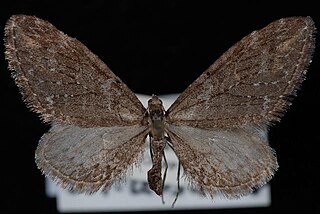Related Research Articles

Eupithecia is the largest genus of moths of the family Geometridae, and the namesake and type genus of tribe Eupitheciini. Species in the genus are, like those of other genera in the tribe, commonly known as pugs. The genus is highly speciose, with over 1400 species, and members of the genus are present in most of the world with exception of Australasia. Roughly a quarter of described Eupithecia species occur in the Neotropical realm, where they have an especially high species diversity in the montane rain forests of the Andes. The genus includes a few agricultural pest species, such as the currant pug moth, Eupithecia assimilata, which is a pest on hops, and the cloaked pug moth, Eupithecia abietaria, which is a cone pest in spruce seed orchards.

Freyer's pug is a moth of the family Geometridae. The species can be found in Europe, east to the Urals, the Russian Far East, Kazakhstan and China. It is also found in North America.

Eupithecia linariata, the toadflax pug, is a moth of the family Geometridae. The species can be found in Europe and from Anatolia to Tajikistan and Iran.

Eupithecia actaeata is a Eurasian species of moth of the family Geometridae.

Eupithecia denotata is a moth in the family Geometridae. The species can be found across the Palearctic from western Europe to Central Asia and China.

Eupithecia breviculata is a moth of the family Geometridae. It is found in the Mediterranean region, Switzerland, Hungary, the Near East and North Africa. It is also found in Iran and Turkmenistan.

Eupithecia distinctaria, the thyme pug, is a moth of the family Geometridae. It is found throughout Europe. It is also found in Iran. from the Iberian Peninsula through western and central Europe including the British Isles as well as further east as far east as far as Russia and Iran. In the north the range reaches as far as the southern Fennoscandia, to the south, where it is more common, it occupies the Mediterranean and Asia Minor. It is found primarily on warm, stony slopes and rocky structures as well as on sparse grassy areas with thyme mounds. In the Alps, it rises to heights of 2000 metres.

Eupithecia silenicolata is a moth in the family Geometridae. It is found from southern Europe and Morocco to western Asia, Iran and Pakistan. In the north, the range extends to southern Switzerland, Austria and northern Italy.
Eupithecia flavigutta is a moth in the family Geometridae first described by George Duryea Hulst in 1896. It is found in the United States in Colorado and montane forest areas in eastern Arizona and south-western New Mexico.
Eupithecia hohokamae is a moth in the family Geometridae first described by Frederick H. Rindge in 1963. It is found in the United States in southern Arizona and California.

Eupithecia anticaria is a moth in the family Geometridae first described by Francis Walker in 1862. It is found from eastern Newfoundland and Labrador across Canada to western British Columbia, south to northern New Mexico and Apache and Coconino counties in Arizona.
Eupithecia macfarlandi is a moth in the family Geometridae first described by Clifford D. Ferris in 2007. It is found in canyons on the east side of the Huachuca Mountains in the US state of Arizona. The habitat consists of oak and oak-conifer forests.
Eupithecia nonanticaria is a moth in the family Geometridae first described by Clifford D. Ferris in 2007. It is found in New Mexico, Arizona and Chihuahua in Mexico. The habitat consists of mixed coniferous forests at elevations above 1,760 meters.
Eupithecia classicata is a moth in the family Geometridae first described by Pearsall in 1909. It is found in the US state of Arizona and the Mexican state of Durango.

Eupithecia rotundopuncta is a moth in the family Geometridae first described by Alpheus Spring Packard in 1871. It is found in western North America from Arizona to the Pacific coast, north to Vancouver Island in British Columbia.
Eupithecia biedermanata is a moth in the family Geometridae first described by Samuel E. Cassino and Louis W. Swett in 1922. It is found in the US state of Arizona.

Eupithecia gilvipennata is a moth in the family Geometridae first described by Samuel E. Cassino and Louis W. Swett in 1922. It is found along the North American Pacific coast from British Columbia, through Colorado to California and Arizona.

Eupithecia scabrogata is a moth in the family Geometridae first described by Pearsall in 1912. It is found in western North America from British Columbia to California and Arizona.

Eupithecia zekiyae is a species of moth in the family Geometridae first described by McDunnough (1946), although the authorship of the currently valid species name is Koçak, 1986.
Eupithecia dearmata is a moth in the family Geometridae. It is found in Turkey. Adults have dull grey wings with a large number of scattered dark scales and a wing span of 14–15 mm.
References
- ↑ Ferris, Clifford D. (2007). "Three new species of Eupithecia Curtis from Arizona and New Mexico with discussion of associated species (Lepidoptera: Geometridae: Eupitheciini)" (PDF). Zootaxa. 1516: 49–60. doi: 10.11646/zootaxa.1516.1.5 .